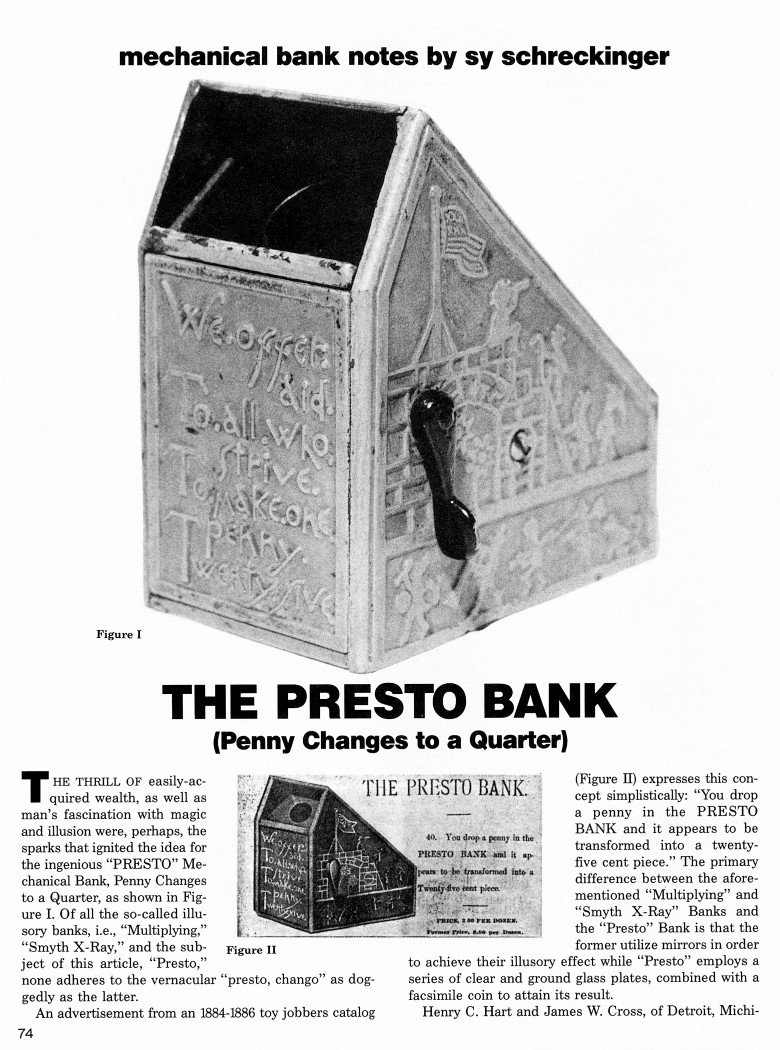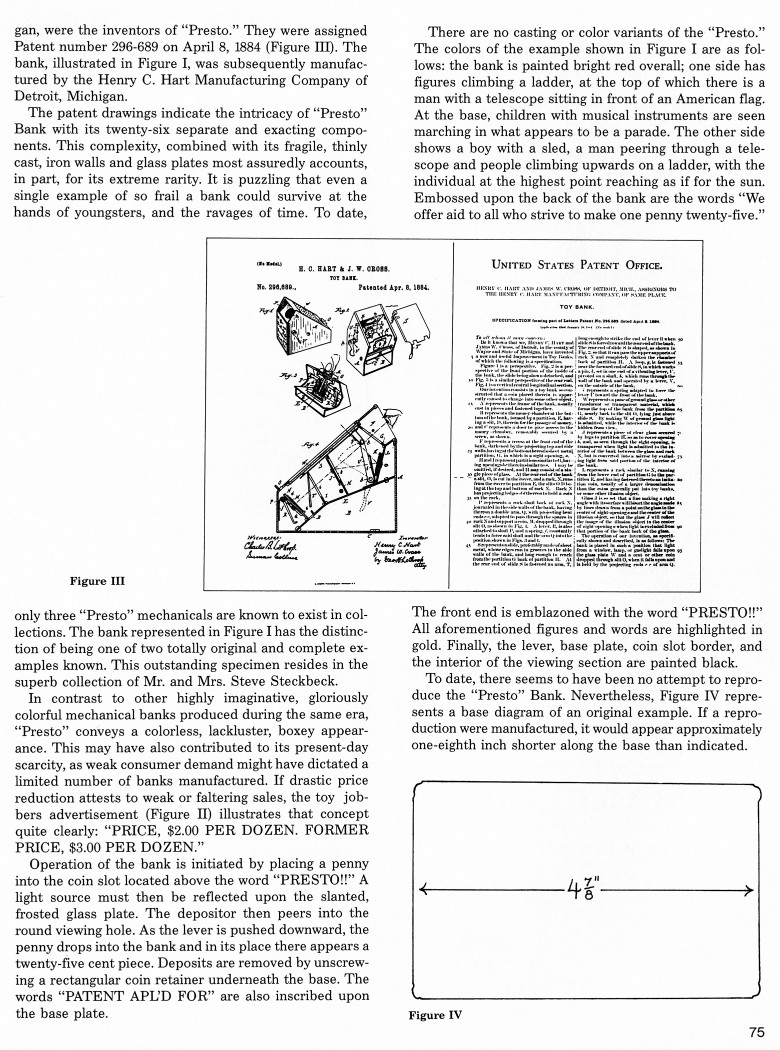|
The Presto Bank
(Penny Changes to a Quarter)
by Sy Schreckinger – ANTIQUE TOY WORLD Magazine – May, 1993
The thrill of easily-acquired wealth, as well
as man's fascination with magic and illusion were, perhaps, the sparks
that ignited the idea for the ingenious "PRESTO" Mechanical Bank, Penny
Changes to a Quarter, as shown in Figure I. Of all the so-called illusory
banks, i.e., "Multiplying," "Smyth X-Ray," and the subject of this
article, "Presto," none adheres to the vernacular "presto, chango" as
doggedly as the latter.
An advertisement from an 1884-1886 toy jobbers catalog (Figure II)
expresses this concept simplistically: "You drop a penny in the PRESTO
BANK and it appears to be transformed into a twenty-five cent piece." The
primary difference between the aforementioned "Multiplying" and "Smyth
X-Ray" Banks and the "Presto" Bank is that the former utilize mirrors in
order to achieve their illusory effect while "Presto" employs a series of
clear and ground glass plates, combined with a facsimile coin to attain
its result.
Henry C. Hart and James W. Cross, of Detroit, Michigan, were the
inventors of "Presto." They were assigned Patent number
296,689 on April
8, 1884 (Figure III). The bank, illustrated in Figure I, was subsequently
manufactured by the Henry C. Hart Manufacturing Company of Detroit,
Michigan.
The patent drawings indicate the intricacy of "Presto" Bank with its
twenty-six separate and exacting components. This complexity, combined
with its fragile, thinly cast, iron walls and glass plates most assuredly
accounts, in part, for its extreme rarity. It is puzzling that even a
single example of so frail a bank could survive at the hands of
youngsters, and the ravages of time. To date, only three "Presto"
mechanicals are known to exist in collections. The bank represented in
Figure I has the distinction of being one of two totally original and
complete examples known. This outstanding specimen resides in the superb
collection of Mr. and Mrs. Steve Steckbeck.
In contrast to other highly imaginative, gloriously colorful
mechanical banks produced during the same era, "Presto" conveys a
colorless, lackluster, boxey appearance. This may have also contributed
to its present-day scarcity, as weak consumer demand might have dictated a
limited number of banks manufactured. If drastic price reduction attests
to weak or faltering sales, the toy jobbers advertisement (Figure 11)
illustrates that concept quite clearly: "PRICE, $2.00 PER DOZEN. FORMER
PRICE, $3.00 PER DOZEN."
Operation of the bank is initiated by placing a penny into the coin
slot located above the word "PRESTO!!'' A light source must then be
reflected upon the slanted, frosted glass plate. The depositor then peers
into the round viewing hole. As the lever is pushed downward, the penny
drops into the bank and in its place there appears a twenty-five cent
piece. Deposits are removed by unscrewing a rectangular coin retainer
underneath the base. The words "PATENT APL'D FOR" are also inscribed upon
the base plate.
There are no casting or color variants of the "Presto." The colors of
the example shown in Figure I are as follows: the bank is painted bright
red overall; one side has figures climbing a ladder, at the top of which
there is a man with a telescope sitting in front of an American flag. At
the base, children with musical instruments are seen marching in what
appears to be a parade. The other side shows a boy with a sled, a man
peering through a telescope and people climbing upwards on a ladder, with
the individual at the highest point reaching as if for the sun. Embossed
upon the back of the bank are the words "We offer aid to all who strive to
make one penny twenty-five." The front end is emblazoned with the word
"PRESTO!!' All aforementioned figures and words are highlighted in gold.
Finally, the lever, base plate, coin slot border, and the interior of the
viewing section are painted black.
To date, there seems to have been no attempt to reproduce the
"Presto" Bank. Nevertheless, Figure IV represents a base diagram of an
original example. If a reproduction were manufactured, it would appear
approximately one-eighth inch shorter along the base than indicated.
|


